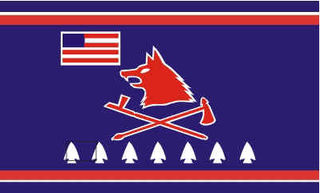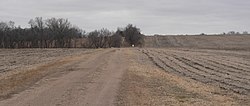
The Pawnee are a Central Plains Indian tribe that historically lived in Nebraska and northern Kansas but today are based in Oklahoma. They are the federally recognized Pawnee Nation of Oklahoma, who are headquartered in Pawnee, Oklahoma. Their Pawnee language belongs to the Caddoan language family, and their name for themselves is Chatiks si chatiks or "Men of Men".
Pawnee mythology is the body of oral history, cosmology, and myths of the Pawnee people concerning their gods and heroes. The Pawnee are a federally recognized tribe of Native Americans, originally located on the Great Plains along tributaries of the Missouri and Platte Rivers in Nebraska and Kansas and currently located in Oklahoma. They traditionally speak Pawnee, a Caddoan language. The Pawnees lived in villages of earth lodges. They grew corn and went on long bison hunts on the open plains twice a year. The tribe has four bands: the Skidi and "the South Bands" consisted of the Chawi, the Kitkahahki and the Pitahawirata Pawnee.

Central City is a city and the county seat of Merrick County, Nebraska, United States. It is part of the Grand Island, Nebraska Metropolitan Statistical Area. The population was 2,934 at the 2010 census.

Arikara, also known as Sahnish, Arikaree, Ree, or Hundi, are a tribe of Native Americans in North Dakota. Today, they are enrolled with the Mandan and the Hidatsa as the federally recognized tribe known as the Mandan, Hidatsa, and Arikara Nation.

The Brulé are one of the seven branches or bands of the Teton (Titonwan) Lakota American Indian people. They are known as Sičhą́ǧu Oyáte —Sicangu Oyate—, Sicangu Lakota, or "Burnt Thighs Nation". Learning the meaning of their name, the French called them the Brûlé. The name may have derived from an incident where they were fleeing through a grass fire on the plains.

Waconda Spring, or Great Spirit Spring, was a natural artesian spring located in Mitchell County, near the communities of Glen Elder and Cawker City in the U.S. state of Kansas. It was a sacred site for Native American tribes of the Great Plains and, for a time, became the site of a health spa for American settlers. With the completion of the Glen Elder Dam in 1968, the mineral spring was sealed then disappeared beneath the waters of Waconda Reservoir.

Nebraska Highway 92 is a highway that enters the state from Nebraska's western border at the Wyoming state line west of Lyman, Nebraska, to the state's eastern border on the South Omaha Veterans Memorial Bridge over the Missouri River in Omaha, where it enters Iowa. Nebraska Highway 92 passes, follows, or runs through a number of the state's principal attractions, including Scotts Bluff National Monument, the Oregon Trail, Chimney Rock National Historic Site, Ash Hollow State Historical Park, Lake McConaughy, the Nebraska Sand Hills, and the City of Omaha. Nebraska Highway 92 is the longest state route in the state at a total of 489.1 miles (787.1 km), and is part of a continuous 886-mile (1,426 km) four-state "Highway 92" which begins in Torrington, Wyoming, goes through Nebraska and Iowa and ends in La Moille, Illinois. It is the only Nebraska Highway to run from the west border to the east border of Nebraska; along the way it crosses the Platte River or its tributary North Platte River a total of five times.

Pohocco Township is one of twenty-four townships in Saunders County, Nebraska, United States. The population was 1,207 at the 2020 census. A 2021 estimate placed the township's population at 1,238.

The Palmer Site, also known as the Skidi Pawnee Village and designated by the Smithsonian trinomial 25HW1, is a prehistoric and historic archeological site near Palmer, Nebraska in Howard and Merrick Counties. The site is a Native American habitation site associated with the Skidi people, a branch of the Pawnee people, which may have been documented by an American exploratory expedition led by Stephen H. Long in 1820. It was declared a National Historic Landmark in 1964. The site is located on private property.

The Pike-Pawnee Village Site, or Hill Farm Site, designated 25WT1 by archaeologists, is a site near the village of Guide Rock in Webster County, in the south central portion of the state of Nebraska, in the Great Plains region of the United States. It was the location of a village of the Kitkehahki band of the Pawnee people, in a region of the Republican River valley that they occupied intermittently from the 1770s to the 1820s.

The Mid-America Council of the Boy Scouts of America offers programs in 58 counties in Nebraska, Iowa and South Dakota. The Mid-America Council was formed from a merger of the Covered Wagon Council and the Southwest Iowa Council in 1965. The first recorded Council in the area was in 1918 as the Omaha Council. In 2000 the council merged with the Prairie Gold Council that had been located in Sioux City, Iowa.

Native American tribes in the U.S. state of Nebraska have been Plains Indians, descendants of succeeding cultures of indigenous peoples who have occupied the area for thousands of years. More than 15 historic tribes have been identified as having lived in, hunted in, or otherwise occupied territory within the current state boundaries.

The Massacre Canyon battle took place in Nebraska on August 5, 1873, near the Republican River. It was one of the last hostilities between the Pawnee and the Sioux and the last battle/massacre between Great Plains Indians in North America. The massacre occurred when a large Sioux war party of over 1,500 Oglala, Brulé, and Sihasapa warriors, led by Two Strike, Little Wound, and Spotted Tail attacked a band of Pawnee during their summer buffalo hunt. In the ensuing rout, many Pawnees were killed with estimates of casualties ranging widely from around 50 to over 150. The victims, who were mostly women and children, suffered mutilation and sexual assault.

Guide Rock, whose Pawnee name is Pa-hur or Pahur, is a hill in south central Nebraska in the United States. In the traditional Pawnee religion, it was one of five dwelling places of spirit animals with miraculous powers.

French people have been present in the U.S. state of Nebraska since before it achieved statehood in 1867. The area was originally claimed by France in 1682 as part of La Louisiane, the extent of which was largely defined by the watershed of the Mississippi River and its tributaries. Over the following centuries, explorers of French ethnicity, many of them French-Canadian, trapped, hunted, and established settlements and trading posts across much of the northern Great Plains, including the territory that would eventually become Nebraska, even in the period after France formally ceded its North American claims to Spain. During the 19th century, fur trading gave way to settlements and farming across the state, and French colonists and French-American migrants continued to operate businesses and build towns in Nebraska. Many of their descendants continue to live in the state.

The Skidi is one of four bands of Pawnee people, a central Plains tribe. They lived on the Central Plains of Nebraska and Kansas for most of the millennium prior to European contact. The Skidi, also known as the Wolf band lived in the northern part of Pawnee territory.
The Pawnee capture of the Cheyenne Sacred Arrows occurred around 1830 in central Nebraska, when the Cheyenne attacked a group from the Skidi Pawnee tribe, who were hunting bison. The Cheyenne had with them their sacred bundle of four arrows, called the Mahuts. During the battle, this sacred, ceremonial object was taken by the Pawnee. The Cheyenne initially made replica arrows but also tried to get the originals back. They recovered one from the Pawnee directly, either given to them or taken by them, and a second was captured by the Lakota and returned to the Cheyenne in exchange for horses. The two corresponding replicas were ceremonially returned to the Black Hills, where the arrows were traditionally believed to have originated. Eventually the bundles were re-established and the societies and their ceremonies continue into the present day.

This article details the effects of white settler contact on the Pawnee tribe, firstly the tribe ceded its land in Nebraska which it had held since the 16th century and was relocated to Oklahoma. Secondly, despite generally having peaceful relations with settlers, there was a loss of life from European-introduced diseases. Lastly came the adoption of European customs, and culture.


















